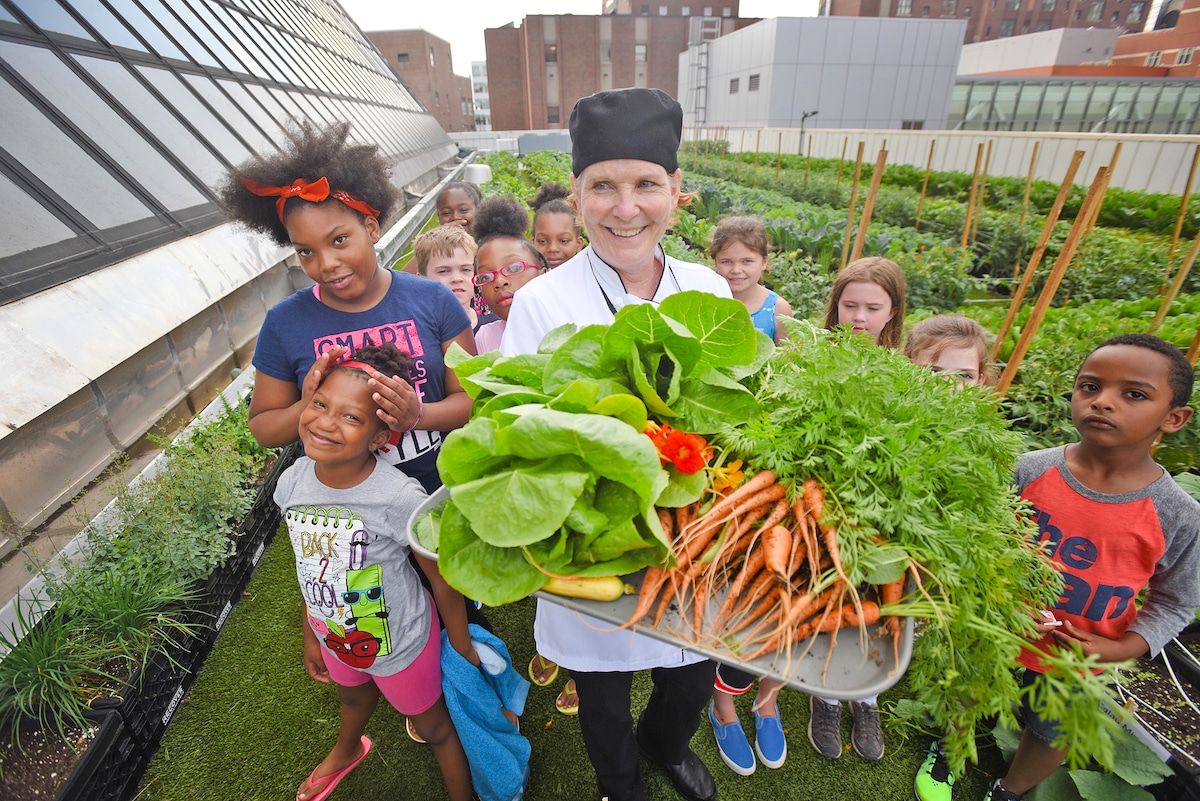Carbon Dioxide From Human Breath Can Be Used as Fertilizer for Rooftop Gardens, Scientists Say

 Why you can trust us
Why you can trust us
Founded in 2005 as an Ohio-based environmental newspaper, EcoWatch is a digital platform dedicated to publishing quality, science-based content on environmental issues, causes, and solutions.
Humans breathe in oxygen and breathe out carbon dioxide, and plants turn carbon dioxide into glucose for food, so it makes sense that our breath could be used as fertilizer, right? Scientists at Boston University who recently conducted a study using carbon dioxide from classrooms as fertilizer for their rooftop garden think so.
In the study, the researchers repurposed the carbon dioxide from a campus building’s rooftop exhaust vents to help plants in their experimental BIG GRO rooftop garden, reported Popular Mechanics. They found that some of the spinach plants grew to four times the size of a control group in the same vicinity.
“We wanted to test whether there was an untapped resource in buildings that could be used to grow plants in rooftop farms,” said lead author of the study Sarabeth Buckley, who is now at the University of Cambridge, in a press release. “Creating more favorable conditions that boost growth could help make rooftop farms more successful and therefore more viable options for installation on buildings.”
The study, “Enhancing crop growth in rooftop farms by repurposing CO2 from human respiration inside buildings,” was published in Frontiers in Sustainable Food Systems.
The increase of vegetation in urban settings in general could help with some of the environmental difficulties that go along with farming and pollution, the study said.
The scientists grew corn and spinach in two groups: one that was fanned with carbon dioxide exhaust and a control group fanned without carbon dioxide. Corn and spinach were chosen because, while both are relatively common and edible, they use different photosynthetic pathways — adaptations that allow them to conduct different variations of the light-independent reactions.
Spinach plants that were grown beside the two rooftop exhaust vents that fanned them with carbon dioxide quadrupled their biomass compared to those next to the control fan. When high winds reduced the concentration of carbon dioxide that reached the plants, the spinach still grew to two times the size of the control plants, but there are still some questions.
“There are still many aspects of this system that must be determined before it can be implemented, such as the optimal air application design and the possible extent of the enhanced growth effect,” said Buckley, as Popular Mechanics reported. “Also, there is a decrease in growth with increased wind speed, so the optimal wind speed would need to be found and incorporated into the system design.”
According to the study, the findings indicate “initial support for a conceptual system that creates a more circular carbon process within buildings, taking high concentrations of CO2 from human respiration and moving it to a rooftop farm where it can be applied for functional use to produce food that can be eaten by humans and respired anew. Enhancing plant growth would make rooftop farms more productive and potentially capable of surviving harsher conditions, expanding their viability as an urban greening strategy.”
The researchers kept track of the carbon levels on the rooftop and in the 20 classrooms used in the study, reported Popular Mechanics. Buckley said that when people were inside the building, high carbon levels were found at the exhaust vents on the rooftop and in the classrooms.
“CO2 levels average above 1,000 parts per million — the recommended limit — in classrooms and above 800 parts per million — high enough to increase growth in plants — at the rooftop exhaust vents,” said Buckley, as Popular Mechanics reported.
However, not all of the growth results were necessarily entirely the result of exposure to carbon dioxide. For example, the corn exposed to the exhaust fans was two to three times bigger than the control plants, but corn has a different photosynthetic pathway than spinach, which means it reaps less benefits from carbon dioxide. Its growth increases may have been the result of the increased temperatures from the exhaust fan.
A recent study conducted by scientists in France, “The decline of plant mineral nutrition under rising CO2: physiological and molecular aspects of a bad deal,” which was published in the journal Trends in Plant Science, found that plants like spinach that use the most common C3 photosynthesis pathway — the one used by almost all trees — that are grown in an environment with higher concentrations of carbon dioxide contain fewer nutrients.
These plants can contain from five to 25 percent less potassium, iron and other nutrients, depending on the level of carbon dioxide, reported Popular Mechanics. This could indicate that plants could be less nutrient-dense as carbon levels increase with global warming. However, according to the French study, the increase of plant biomass would still have benefits for reducing carbon dioxide levels in the atmosphere and helping with contemporary food needs.
Buckley’s wish is that the study conducted by her research team leads to the BIG GRO system being further developed and used with rooftop gardens and farms.
“If that happens, then hopefully more rooftop farms will be installed. They could provide a multitude of environmental and social benefits such as energy savings for the building, carbon drawdown, climate mitigations, urban heat reduction, local food production, community building opportunities, and aesthetic and mental health benefits,” Buckley said, as Popular Mechanics reported.
Subscribe to get exclusive updates in our daily newsletter!
By signing up, you agree to the Terms of Use and Privacy Policy & to receive electronic communications from EcoWatch Media Group, which may include marketing promotions, advertisements and sponsored content.

 233k
233k  41k
41k  Subscribe
Subscribe 




